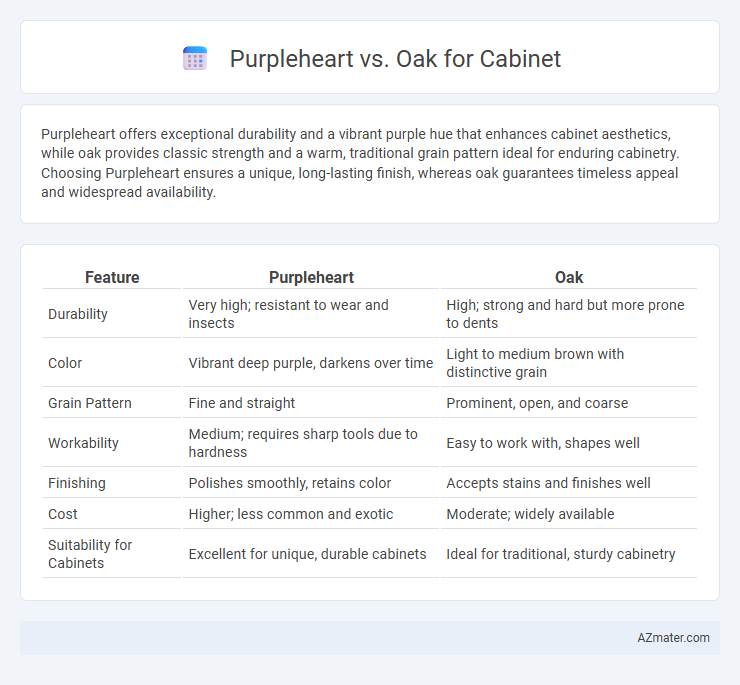Purpleheart offers exceptional durability and a vibrant purple hue that enhances cabinet aesthetics, while oak provides classic strength and a warm, traditional grain pattern ideal for enduring cabinetry. Choosing Purpleheart ensures a unique, long-lasting finish, whereas oak guarantees timeless appeal and widespread availability.
Table of Comparison
| Feature | Purpleheart | Oak |
|---|---|---|
| Durability | Very high; resistant to wear and insects | High; strong and hard but more prone to dents |
| Color | Vibrant deep purple, darkens over time | Light to medium brown with distinctive grain |
| Grain Pattern | Fine and straight | Prominent, open, and coarse |
| Workability | Medium; requires sharp tools due to hardness | Easy to work with, shapes well |
| Finishing | Polishes smoothly, retains color | Accepts stains and finishes well |
| Cost | Higher; less common and exotic | Moderate; widely available |
| Suitability for Cabinets | Excellent for unique, durable cabinets | Ideal for traditional, sturdy cabinetry |
Introduction to Purpleheart and Oak
Purpleheart, renowned for its vibrant purple hue and exceptional durability, offers a unique aesthetic well-suited for distinctive cabinetry. Oak, a classic hardwood prized for its strength, prominent grain pattern, and versatility, remains a popular choice for both traditional and contemporary cabinets. Both woods provide excellent stability and wear resistance, making them ideal options for high-quality cabinet construction.
Key Differences in Appearance
Purpleheart wood features a vibrant, deep purple hue that intensifies with exposure to light, providing a unique and eye-catching appearance for cabinets. Oak, in contrast, displays a classic grain pattern with warm, neutral tones ranging from light beige to rich brown, offering a timeless and versatile look. The dense and smooth texture of Purpleheart contrasts with oak's coarser grain, making each wood distinct in both color and tactile experience.
Durability and Hardness Comparison
Purpleheart offers exceptional durability with a Janka hardness rating around 2,520, making it significantly harder and more resistant to dents than oak, which typically registers between 1,200 to 1,360. This higher hardness level ensures purpleheart cabinets withstand heavy use and resist wear better over time compared to oak. Oak's moderate hardness provides good durability for standard cabinetry but is more prone to scratches and dents under heavy impact.
Workability and Ease of Use
Purpleheart offers moderate workability with a tendency to dull tools quickly due to its hardness, making it less user-friendly for intricate cabinet work. Oak, known for its excellent workability and smooth sanding properties, allows for easier shaping, cutting, and finishing, ideal for cabinetry. For projects requiring frequent tool changes and fine detailing, oak presents fewer challenges compared to the dense, challenging grain of purpleheart.
Cost and Availability
Purpleheart is generally more expensive than oak due to its exotic origin and limited availability, making it a premium choice for cabinets. Oak, widely grown in North America and Europe, offers greater availability and a more budget-friendly cost, ideal for large-scale or cost-conscious projects. The price difference reflects not only material scarcity but also the specialized handling required for Purpleheart compared to the readily accessible oak.
Environmental Impact and Sustainability
Purpleheart wood is sourced from sustainably managed tropical rainforests, often certified by organizations like FSC, ensuring responsible harvesting and minimal environmental disruption. Oak, widely available in temperate regions, is known for fast growth and efficient regeneration, which supports sustainable forestry practices and carbon sequestration. Both woods have durable qualities suitable for cabinetry, but Purpleheart's slower growth requires careful management to maintain its environmental benefits compared to the more renewable nature of Oak.
Maintenance and Longevity
Purpleheart wood offers exceptional durability and resistance to wear, making it highly low-maintenance compared to oak, which requires more frequent polishing and sealing to prevent moisture damage. Oak cabinets have a strong traditional appeal but may show signs of aging such as scratches and stains over time, whereas purpleheart maintains its structural integrity and vibrant color with minimal upkeep. Longevity in cabinet construction favors purpleheart due to its dense, hard grain that withstands heavy use and environmental changes better than oak.
Best Applications for Each Wood
Purpleheart offers exceptional durability and vibrant color, making it ideal for decorative cabinet fronts and accent pieces where a bold visual impact is desired. Oak's strength, workability, and classic grain patterns suit structural cabinet components and traditional-style cabinetry requiring stability and timeless appeal. Both woods excel in high-traffic areas, but Purpleheart's hardness resists dents better, while Oak is preferred for its ease of finishing and ability to match various design aesthetics.
Style and Design Compatibility
Purpleheart wood offers a striking deep purple hue that enhances modern and eclectic cabinetry designs, providing a bold, vibrant statement piece. Oak features a classic, warm grain pattern ideal for traditional and rustic styles, offering timeless appeal and versatile blending with various decor themes. The choice between Purpleheart and Oak hinges on whether the goal is to achieve a unique, colorful aesthetic or a more conventional, enduring look in cabinet design.
Final Verdict: Which Is Better for Cabinets?
Purpleheart offers exceptional durability and a rich, vibrant color that deepens over time, making it ideal for high-end, visually striking cabinets. Oak provides consistent strength, a classic grain pattern, and ease of finishing, which suits traditional and versatile cabinet designs. For cabinets requiring long-lasting performance with a distinctive appearance, Purpleheart is superior, while Oak remains a practical choice for timeless aesthetics and budget-friendly projects.

Infographic: Purpleheart vs Oak for Cabinet
 azmater.com
azmater.com